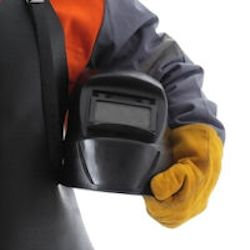Medium and Heavy Welding
Flameproof Clothing: During medium and heavy welding, specially designed flameproof clothing made of leather, or other suitable material, may be required.

Protective Clothing: A wide choice of protective clothing is available so you can select the type required for any particular welding or cutting job. This clothing consists of aprons, sleeves, a combination of sleeves and bib, jackets, and overalls.
Consider the following when selecting protective clothing:
- Capes and sleeves are particularly suitable for overhead welding because the cape protects the back of the neck, top of the shoulders, and upper part of the back and chest.
- Bib in combination with the cape and sleeves gives added protection to the chest and abdomen in jobs where protection for the lower part of the back is not required.
- Jackets: Wear the jacket when full upper-body protection is needed — for example, when working near several other welders.
- Aprons and Overalls: Aprons and overalls provide protection to the legs and, therefore, are suitable for welding operations on the floor.
- Leggings/Boots: For very heavy work, wear fire-resistant leggings or high boots. Do NOT wear shoes or boots that have exposed nail heads or rivets.
Knowledge Check Choose the best answer for the question.
6-5. What protective equipment protects the legs and is therefore suitable for welding operations on the floor?
You forgot to answer the question!
